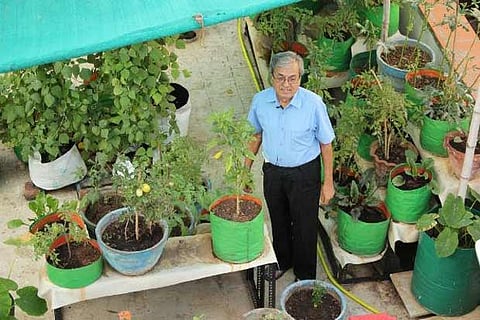

Chennai
With the growing needs of the society, the consumption of resources has also burgeoned. As a result, the prices of supplies and commodities have increased manifold burning sizeable holes in our pocket. Though there are solutions available right under our nose, the society seldom gives any heed to it. With countries like China, Japan, Germany, and the US slowly transitioning to eco-friendly methods, Indians are slowly switching to solar power as a source of energy, but with much apprehensions and misconceptions.
To provide right advice and erase the fallacies regarding sustainable resources, city-based Dwarkadas Suresh, popularly known as Solar Suresh has converted his living space into a self-sustaining habitat by successfully utilising these misconceived methods.
An IIT Madras, IIM Ahmedabad graduate with over 50 years of corporate experience, Suresh plunged into environmental-friendly resources when he visited Germany over 20 years ago. The retired corporate professional is now enjoying his green home with literally zero expenses for amenities like electricity, cooking gas and vegetables.
Power of sun to light up the house “During my frequent visits to Germany, I noticed that most of the houses had installed roof top solar plants.
If a country with a lot less sunshine can install these facilities, then why not implement the same in Chennai which has solar energy in abundance?
So, I interacted with a lot of vendors, but no one agreed to install roof top panels. It was hard to find a suitable solar plant vendor and to get a proper solar inverter in those days. Finally, I located a local vendor who had the same interest as mine and designed the solar power plant to power my house.” Suresh, who started with 1 Kilowatt (kW) capacity of solar plant expanded into 3kW capacity by 2015. “Every appliance at my home is powered by solar energy except water heater. I have not experienced power cuts in the last four years even during Cyclone Vardah. The electricity charges are saved by producing around 12-16 units a day and there is no maintenance, except for cleaning the panels. The major advantage is that it produces power during mild and rainy days, generates non-polluting power, does not work on fossil fuel and thus saves foreign exchange for the country,” adds the IIM Ahmedabad alumni.
He feels that the government has been extending support to the public by introducing cheaper solar installation method like Net Metering which is a daily storage-and-use facility without a battery, saving 40 per cent of the installation cost. However, lack of public cooperation results in failure of such initiatives.
Peer projects
When we ask him about the other environment friendly projects that he has installed at his residence, Suresh says, “I have installed indoor biogas plant of 1 cubic metre to process around 3-4 kg organic waste per day, and it produces to about 20 kg of gas per month, which suffices the cooking fuel needs of my house. The waste which is generated is converted into two useful resources- cooking gas and organic manure. The installation process is very simple and it generates no odour. The entire process is automatic except feeding the plant daily and needs minimal care while feeding organic waste into the system. When Solid Waste Management is a burning issue in our society what can be a better way of garbage management?” He adds, “Next one is rain water harvesting that I started 20 years ago.
Now there are two types of RWH – first is filter and store use and second is recharge groundwater use. In the first case, rainwater is collected and filtered through a simple organic filtration by using pebbles, charcoal and river sand. This water can be used for cooking and drinking purpose.
The second case is when the rainwater accumulates or stagnates, a pipe with holes every foot is inserted into the ground such that water goes into the pipe and recharges groundwater.
Apart from these, I have a terrace kitchen garden. I started with five pots and sowed seeds and now there are 120 earthen pots with 10-15 types of vegetables, all of them organically grown out of the bio-manure generated out of the biogas plant. The results are definitely sweet, as we do not go to the market to buy vegetables, as we have everything around us.” Experience on going green
“We have created a lush forest-like atmosphere with bamboo plants, creepers and shoots, which separates me from the chaotic traffic. We are definitely feeling great by living with the nature,” says Suresh.
When we ask the Septuagenarian on spreading the awareness among the public, he says, “I do a whole lot of speeches, conferences across India to spread awareness and encourage community to take to such practices, however, there is this question on ‘Return On Investment’ (ROI) which bogs me down.
When we don’t calculate the ROI, while purchasing home appliances or dresses then why be hesitant towards a one-time environment friendly investment? If we aim to achieve a sustainable future, public’s thought process should alter. As the famous quote by John F Kennedy goes, ‘Ask not what your country can do for you, ask what you can do for your country,” concludes Suresh.
Visit news.dtnext.in to explore our interactive epaper!
Download the DT Next app for more exciting features!
Click here for iOS
Click here for Android